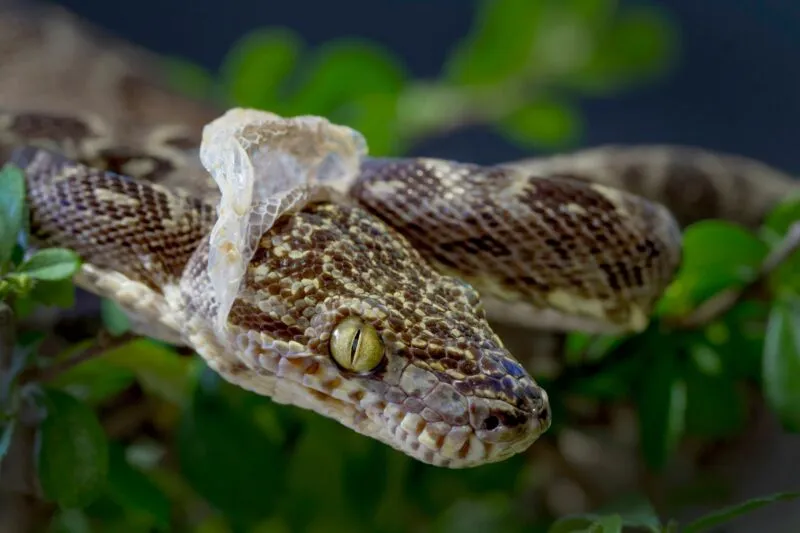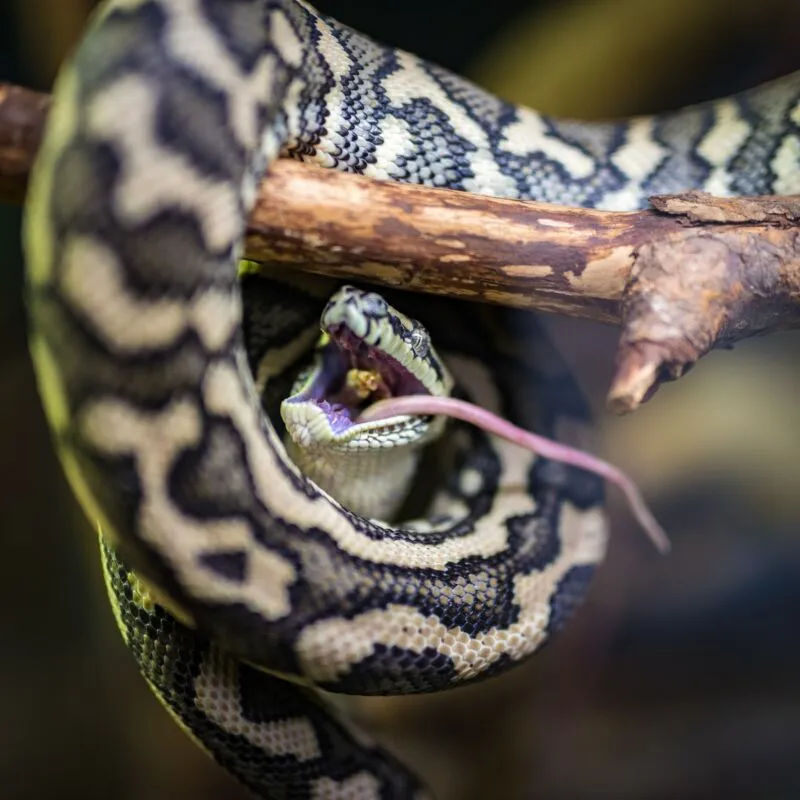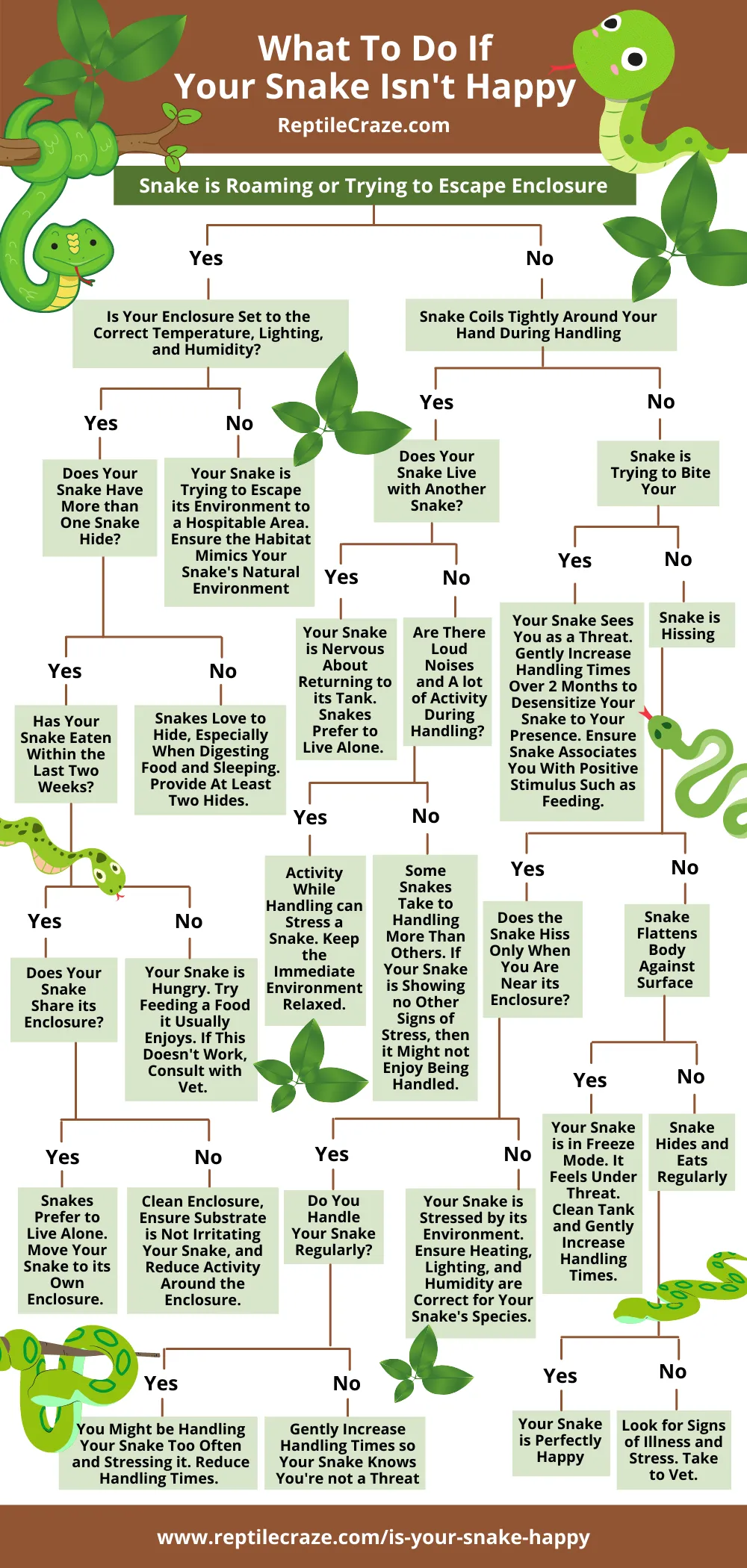
How can you tell if your snake is happy? Your snake buddy can’t just tell you how he or she is feeling (unless you’re Harry Potter). Luckily, there are several signs to look for to make sure your snake is enjoying its life and is at ease in its environment.
There are at least 10 ways to know if your snake is happy or not. Some of these include body language, hiding behavior, physical condition, eating habits, handling reactions, and how your snake responds to stimuli both inside and outside of its enclosure.
After decades of looking after snakes, I’ve put together a handy list to help you know if your snake is happy. Let’s dive in!
Table of Contents
10 Ways to Tell Your Snake is Happy and Relaxed
1. Slow Movements When Picked Up
While snakes spend most of their lives moving slowly, they can move faster than you think. One way to tell if a snake is stressed is if it attempts to move quicker than usual out of your grip.
This is an escape strategy to avoid danger. A happy snake that is well conditioned for handling, will move slowly when held.
2. Relaxed Grip When Handled
A happy snake will move its body in your hand but in a relaxed way. It might even happily just sit in your hands, not limp or completely still, but aware and happy.
3. Little Hyperfocussing
Snakes hyperfocus on what’s in front of them. They do this most often when focussing on either prey or a predator. This behavior looks like the snake is staring and keeping its head directly in front of its point of interest, even if it moves.
Your snake will hyperfocus naturally, but if it’s doing this whenever you or someone else is near all of the time, it could be a sign that your snake isn’t comfortable around you yet and perceives you as a potential threat.
4. Normal Eating Habits
One of the easiest ways to tell if a snake is healthy and happy is to check its feeding habits. What’s considered normal will depend on the breed, but many snakes will happily eat once every 1 – 2 weeks.
If normal feeding habits cease and your snake isn’t interested in eating, it could be that it is feeling stressed or sick. Remember that healthy shedding tends to interrupt feeding, though.
5. Normal Hiding Behavior
Snakes only hunt every few weeks. They like to spend much of their time hiding. If your snake is in a hide somewhere in its enclosure and comes out to eat when it should, it’s probably quite happy.
6. Healthy Shedding
Depending on your breed of snake, it should shed its skin regularly. This can happen as much as once a month for adult snakes.
Young snakes, often called ‘snakelets’, shed their skin around every two weeks. Older snakes might reduce their shedding to a couple of times a year.
When a healthy snake sheds, it is known as ‘sloughing’. It can take 7 – 14 days for the entire skin to shed from the nose to the tail.
Your snake might move itself across rough objects to speed up this process. Usually, this will happen in one piece.
If the shed isn’t coming off naturally or is regularly happening in patches, this is a sign your snake is either stressed or ill. You might need to bring your snake to a vet or get in contact with an online vet then.

7. Good Air Tasting
It’s one of the most famous snake behaviors: The regular flicking of its forked tongue. It looks cool, but it’s a sign of a happy snake.
When the tongue regularly moves in and out of the mouth like that, it’s actually helping your snake taste air so it can know more about its environment.
On the roof of your snake’s mouth is a collection of receptors that help your snake smell. This is known either as Jacobson’s Organ or the vomeronasal.
When the tongue flicks in and out of the mouth, it scoops up particles from the air and funnels them to this organ.
This is completely healthy behavior, and, in some species such as the Copperhead, it’s been shown that this is a relaxed way for snakes to find out where the nearest mate is!
8. Consistent Personality
It’s a myth that snakes don’t have personalities. While more research is required, any experienced snake owner will tell you that no two snakes are exactly the same, even when of the same breed.
As cognitive sciences improve, more evidence is stacking up that all animals have some form of personality, if we define personality as individual, consistent behaviors.
If you’ve had your snake for a while, then you’ll know what sort of personality your snake has.
I’m not talking about whether it likes watching Animal Planet or has a bad gambling habit, I mean where it likes to hang out, what its usual reaction to different environmental cues are, whether it’s more or less aggressive than usual, etc.
If there is a sudden change in personality, it could be down to new stress. This could be a health problem, an issue with its enclosure, or an evolution of its needs not being met.
9. Sleep or Repose
Because snakes spend much of their time sedentary rather than moving around, they often go to sleep. Needless to say, this only happens when a snake feels relaxed and secure enough.
Because snakes have no eyelids, you can’t easily tell if a snake is sleeping or not from its face. Look at its body language.
Snakes can sleep for as long as 20 hours, especially after a feed.
This means they’ll spend most of this time in a hide or burrow under the substrate for security. This is completely healthy and shows a snake at its most relaxed.
10. Healthy Heating Habits
Snakes are ectotherms and so they need to regulate their body temperature from their environments. How they do this will depend on what species of snake they are.
For example, ball pythons don’t bask in the sunlight, they are primarily nocturnal. They heat their bodies by going into hides or sliding under rocks that have been heated by the sun.
Snakes that do move during the day, tend to move around between shadow and sun to regulate their temperature.
A happy snake will do this naturally. A stressed snake will become even more lethargic than usual and will forgo some of this heating if feeling threatened.

5 Signs Your Snake is NOT Happy
Sometimes it’s easier to tell how at ease your snake is by looking for signs they are unhappy rather than happy. Let’s quickly go over what you can look for if you’re concerned.
1. Roaming or Escape Behavior
If your snake is continually roaming back and forward in your
2. Tight or Coiled Body During Handling
We mentioned that snakes should feel relaxed when handled. If your snake coils around your hands or other body parts tightly, then this is a sign they aren’t happy about being handled.
This doesn’t mean you need to stop, as you’ll need to acclimatize your pet to being handled. You just need to do it by slowly increasing handling times. Be gentle!
3. Striking Behavior
It’s one of the coolest things to see. Your snake strikes at something with its mouth, maybe it’s the glass or prey. But too much striking shows your snake feels threatened.
If it strikes at you whenever you are near the
4. Hissing
If a snake hisses constantly, then it’s trying to warn you to stay away. A quiet snake is often a happy one.
5. Change in Body Posture
When threatened by a predator, a snake will try to make itself smaller so that it’s not noticed. One way to do this is to flatten its body against a surface such as a rock or tree branch.
If your snake is flattening its body either in the
How to Make Your Sure Your Snake Is Happy
There are plenty of ways to make sure that your snake feels relaxed and happy. Have a look at this infographic we created and the further tips below it.

- Patience: Giving your snake time to adjust to a new environment. Don’t change things as soon as you see stressed behaviour unless your snake has been in that environment for some time.
- Hiding Spots: Provide more areas to hide and feel safe within the enclosure. We recommend getting a hide like this. Simply choose the right size for your snake and you are good to go.
- Correct Climate: Check heat, humidity, and lighting are all installed for your specific species of snake.
- Day/Night Cycle: Ensure that your lighting and enclosure temperatures cycle between day and night, mimicking your snake’s natural environment.
- Don’t Overcrowd: Snakes can be competitive and cannibalise each other. Except for some snakes such as the Garter snake, most should be on their own. This is what they like. To crowd snakes together is a sure way to overstress them.
- Proper Nutrition: Re-assess the type of
food you are providing and how often. Make sure your snake is getting thefood and clean water it needs. - Clean
Tank : Make sure your pet’s environment is cleaned regularly and free of faeces, rottingfood or shed skin. - Handling Schedule: Draw up an effective handling schedule where you handle your snake for short durations at first, then slowly lengthen the duration. Remember, some species are happier to be handled than others!
- Correct
Tank Size: It’s absolutely essential that you figure out what is the correct size of tank for a snake. This will change throughout its life. - Nearby Stressors: Evaluate what’s going on around the outside of your snake’s enclosure. Screaming kids tapping the glass? People smoking in the room? So quiet your snake isn’t used to people? It’s a balancing act between giving your snake quiet environment and getting them used to humans.
Conclusion
I hope this article helped you identify whether your snake is happy or not. The main thing is, most issues can be corrected. If you stay patient and make small changes, you’ll soon have a happy and relaxed snake enjoying life!
If you have any questions about your snake’s well-being, please leave them below and I’ll be happy to answer them.
- Eastern Rat Snake: Nature’s Pest Control and Fascinating Reptile - September 20, 2024
- Eastern Racer: The Fast and Agile Snake - September 19, 2024
- The Eastern Indigo Snake: The Majestic, Non-Venomous Hunter of the Southeast - September 18, 2024
